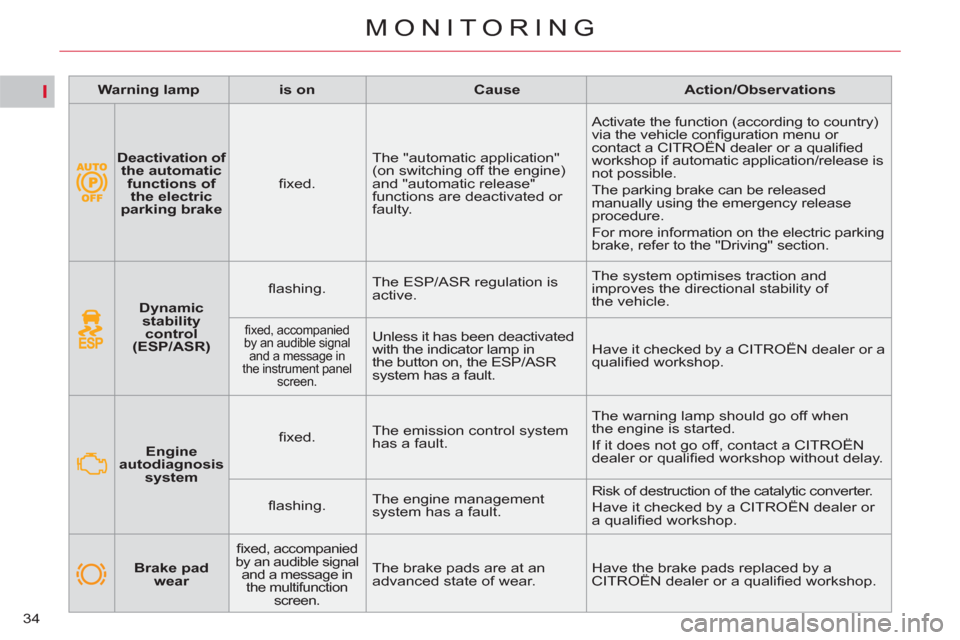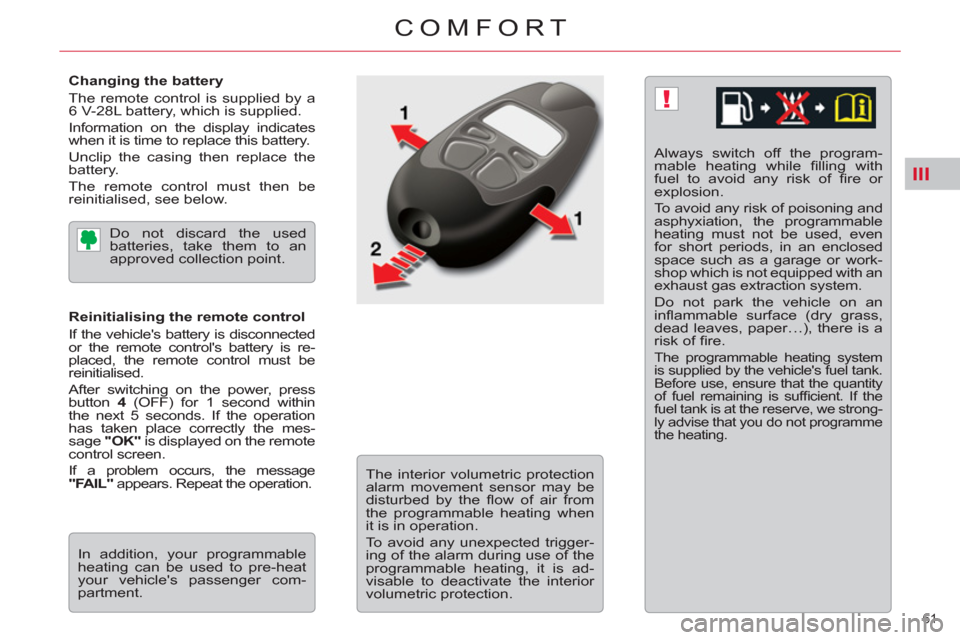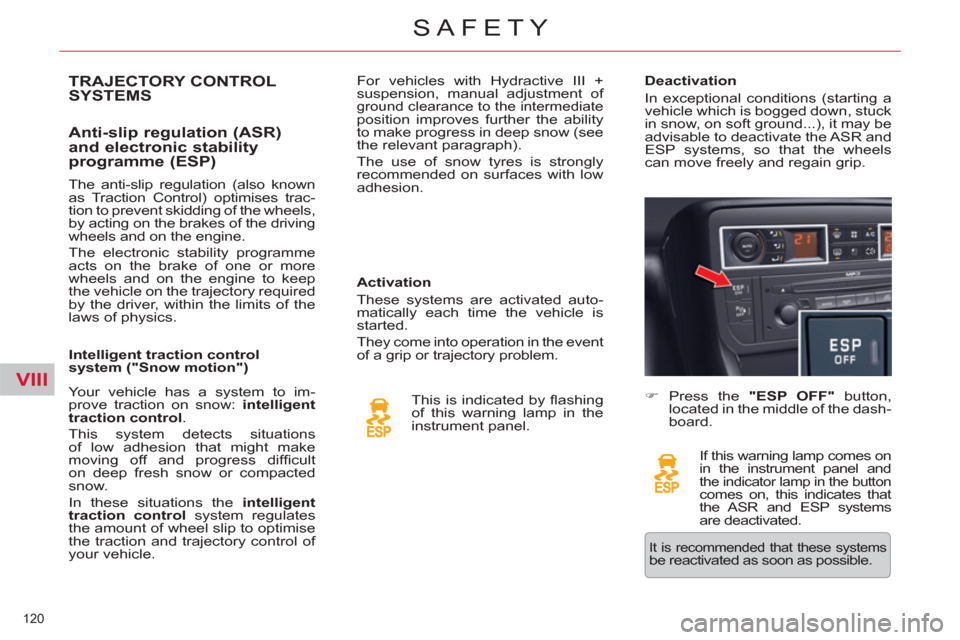traction control Citroen C5 RHD 2011.5 (RD/TD) / 2.G Owner's Manual
[x] Cancel search | Manufacturer: CITROEN, Model Year: 2011.5, Model line: C5 RHD, Model: Citroen C5 RHD 2011.5 (RD/TD) / 2.GPages: 340, PDF Size: 39.33 MB
Page 36 of 340

I
34
MONITORING
Dynamic
stability
control
(ESP/ASR)
fl ashing. The ESP/ASR regulation is
active. The system optimises traction and
improves the directional stability of
the vehicle.
fi xed, accompanied
by an audible signal
and a message in
the instrument panel
screen.
Unless it has been deactivated
with the indicator lamp in
the button on, the ESP/ASR
system has a fault. Have it checked by a CITROËN dealer or a
qualifi ed workshop.
Engine
autodiagnosis
system
fi xed. The emission control system
has a fault. The warning lamp should go off when
the engine is started.
If it does not go off, contact a CITROËN
dealer or qualifi ed workshop without delay.
fl ashing. The engine management
system has a fault. Risk of destruction of the catalytic converter.
Have it checked by a CITROËN dealer or
a qualifi ed workshop.
Warning lamp
is on
Cause
Action/Observations
Brake pad
wear
fi xed, accompanied
by an audible signal
and a message in
the multifunction
screen.
The brake pads are at an
advanced state of wear. Have the brake pads replaced by a
CITROËN dealer or a qualifi ed workshop.
Deactivation of
the automatic
functions of
the electric
parking brake
fi xed. The "automatic application"
(on switching off the engine)
and "automatic release"
functions are deactivated or
faulty. Activate the function (according to country)
via the vehicle confi guration menu or
contact a CITROËN dealer or a qualifi ed
workshop if automatic application/release is
not possible.
The parking brake can be released
manually using the emergency release
procedure.
For more information on the electric parking
brake, refer to the "Driving" section.
Page 63 of 340

III
!
61
COMFORT
Changing the battery
The remote control is supplied by a
6 V-28L battery, which is supplied.
Information on the display indicates
when it is time to replace this battery.
Unclip the casing then replace the
battery.
The remote control must then be
reinitialised, see below.
Always switch off the program-
mable heating while fi lling with
fuel to avoid any risk of fi re or
explosion.
To avoid any risk of poisoning and
asphyxiation, the programmable
heating must not be used, even
for short periods, in an enclosed
space such as a garage or work-
shop which is not equipped with an
exhaust gas extraction system.
Do not park the vehicle on an
infl ammable surface (dry grass,
dead leaves, paper…), there is a
risk of fi re.
The programmable heating system
is supplied by the vehicle's fuel tank.
Before use, ensure that the quantity
of fuel remaining is suffi cient. If the
fuel tank is at the reserve, we strong-
ly advise that you do not programme
the heating.
Do not discard the used
batteries, take them to an
approved collection point.
Reinitialising the remote control
If the vehicle's battery is disconnected
or the remote control's battery is re-
placed, the remote control must be
reinitialised.
After switching on the power, press
button 4
(OFF) for 1 second within
the next 5 seconds. If the operation
has taken place correctly the mes-
sage "OK"
is displayed on the remote
control screen.
If a problem occurs, the message
"FAIL"
appears. Repeat the operation.
In addition, your programmable
heating can be used to pre-heat
your vehicle's passenger com-
partment.
The interior volumetric protection
alarm movement sensor may be
disturbed by the fl ow of air from
the programmable heating when
it is in operation.
To avoid any unexpected trigger-
ing of the alarm during use of the
programmable heating, it is ad-
visable to deactivate the interior
volumetric protection.
Page 122 of 340

VIII
120
SAFETY
TRAJECTORY CONTROL
SYSTEMS
Anti-slip regulation (ASR)
and electronic stability
programme (ESP)
Activation
These systems are activated auto-
matically each time the vehicle is
started.
They come into operation in the event
of a grip or trajectory problem.
This is indicated by fl ashing
of this warning lamp in the
instrument panel.
Deactivation
In exceptional conditions (starting a
vehicle which is bogged down, stuck
in snow, on soft ground...), it may be
advisable to deactivate the ASR and
ESP systems, so that the wheels
can move freely and regain grip.
�)
Press the "ESP OFF"
button,
located in the middle of the dash-
board.
If this warning lamp comes on
in the instrument panel and
the indicator lamp in the button comes on, this indicates that
the ASR and ESP systems
are deactivated.
Your vehicle has a system to im-
prove traction on snow: intelligent
traction control
.
This system detects situations
of low adhesion that might make
moving off and progress diffi cult
on deep fresh snow or compacted
snow
.
In these situations the intelligent
traction control
system regulates
the amount of wheel slip to optimise
the traction and trajectory control of
your vehicle.
The anti-slip regulation (also known
as Traction Control) optimises trac-
tion to prevent skidding of the wheels,
by acting on the brakes of the driving
wheels and on the engine.
The electronic stability programme
acts on the brake of one or more
wheels and on the engine to keep
the vehicle on the trajectory required
by the driver, within the limits of the
laws of physics.
Intelligent traction control
system ("Snow motion") For vehicles with Hydractive III +
suspension, manual adjustment of
ground clearance to the intermediate position improves further the ability
to make progress in deep snow (see
the relevant paragraph).
The use of snow tyres is strongly
recommended on surfaces with low
adhesion.
It is recommended that these systems be reactivated as soon as possible.
Page 336 of 340

334
ALPHABETICAL INDEX
S Spare wheel .......................... 179
Speed limiter ......................... 152
Speedometer ........................... 26
Stability control (ESP) ........... 120
Starting the vehicle .......... 72, 139
Steering lock ........................... 72
Steering mounted
controls ................ 307, 234, 275
Steering wheel, fi xed centred
controls ................................ 150
Stopping the vehicle ........ 72, 139
Stop & Start .......... 30, 53, 57, 86,
143, 164, 174, 198, 296, 318
Storage compartments .......... 101
Storing driving positions .......... 65
Stowing rings ......................... 103
Sunroof .................................... 84
Sun visor ............................... 100
Suspension,
electronic control ................. 160
Synchronising
the remote control ................. 73
System, navigation ........ 240, 279
Systems, ASR and ESP ........ 120
T Table of weights ........... 210, 211,
214-218
Tables of engines .......... 212, 218
Tables of fuses ...................... 193
Tank, fuel ................................. 87
Technical data ................ 209-213
Telephone ...... 227, 257, 293, 314
Telephone, hands-free .......... 257
Temperature, coolant .............. 41
Temperature adjustment ..... 51, 54
Temperature control for heated
seats ...................................... 64
Temporary tyre repair kit ....... 176
Time ...................... 261, 295, 317
TMC (Traffi c info) .......... 249, 287T Tools ...................................... 179
Total distance recorder ............ 42
Towbar ................................... 202
Towing another vehicle .......... 200
Traction control (ASR) ........... 120
Traffi c information
(TA) ............. 250, 288, 289, 310
Traffi c information
(TMC) .......... 249, 250, 287, 288
Trip computer .................... 29, 30
Trip distance recorder ............. 42
Tyre pressures ...................... 223
Tyres ................................... 2, 24
Tyre under-infl ation
detection .............................. 117
U Under-infl ation (detection) ..... 117
Unlocking ................................ 69
Unlocking from the inside ........ 79
USB player ............................ 312
V Vehicle identifi cation .............. 223
Ventilation .......................... 49, 50
Very cold protection ............... 204
Voice commands ................... 232
W Warning lamps ................... 32-34
Wash-wipe, rear ...................... 94
Weights .......... 210, 211, 214-218
Welcome lighting ..................... 98
Wheel, changing ................... 179
Window controls ...................... 77
Wiper, rear ............................... 94
Wiper control stalk ............. 94, 95
Wipers ............................... 94, 95
X Xenon headlamps ................. 183